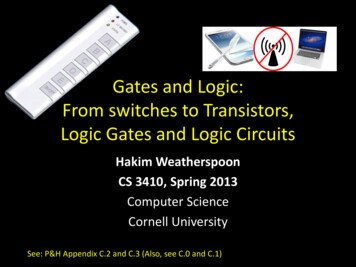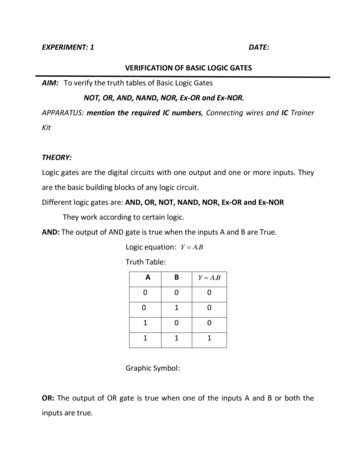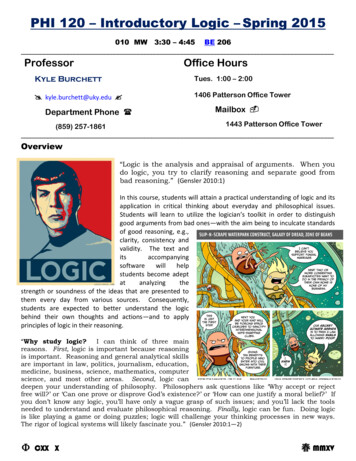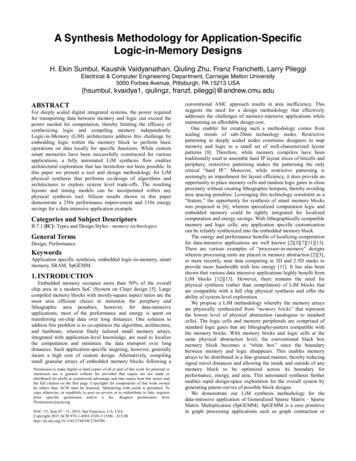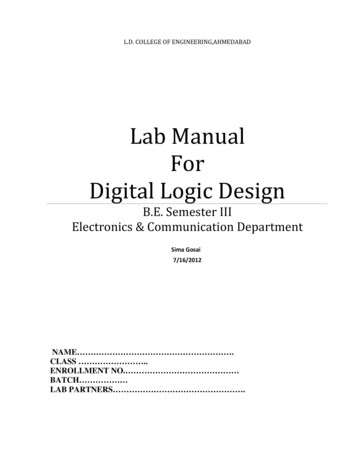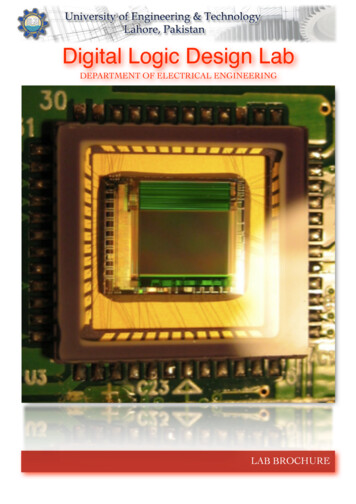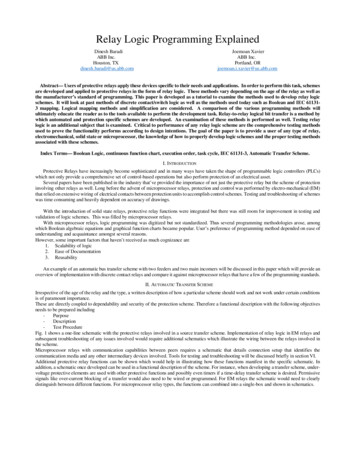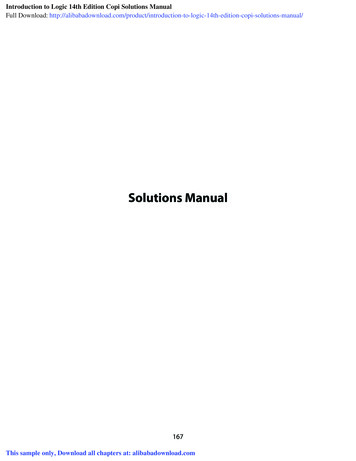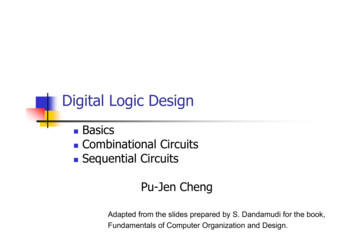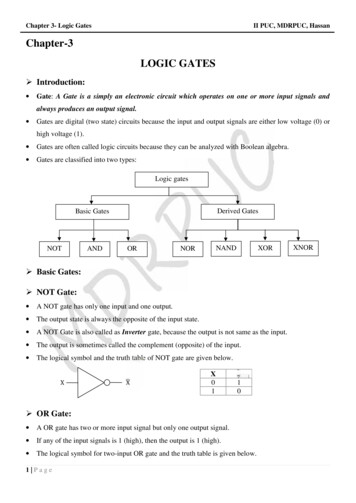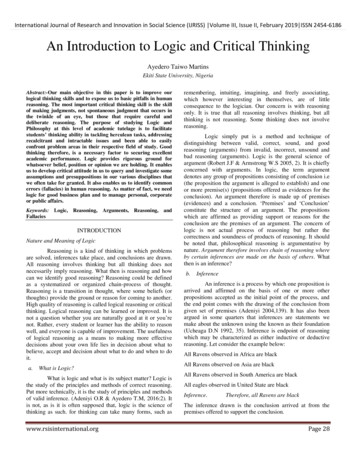
Transcription
International Journal of Research and Innovation in Social Science (IJRISS) Volume III, Issue II, February 2019 ISSN 2454-6186An Introduction to Logic and Critical ThinkingAyedero Taiwo MartinsEkiti State University, NigeriaAbstract:-Our main objective in this paper is to improve ourlogical thinking skills and to expose us to basic pitfalls in humanreasoning. The most important critical thinking skill is the skillof making judgments, not spontaneous judgment that occurs inthe twinkle of an eye, but those that require careful anddeliberate reasoning. The purpose of studying Logic andPhilosophy at this level of academic tutelage is to facilitatestudents’ thinking ability in tackling herculean tasks, addressingrecalcitrant and intractable issues and been able to easilyconfront problem areas in their respective field of study. Goodthinking therefore, is a necessary factor to securing excellentacademic performance. Logic provides rigorous ground forwhatsoever belief, position or opinion we are holding. It enablesus to develop critical attitude in us to query and investigate someassumptions and presuppositions in our various disciplines thatwe often take for granted. It also enables us to identify commonerrors (fallacies) in human reasoning. As matter of fact, we needlogic for good business plan and to manage personal, corporateor public affairs.Keywords: Logic, Reasoning, Arguments, Reasoning, andFallaciesINTRODUCTIONNature and Meaning of LogicReasoning is a kind of thinking in which problemsare solved, inferences take place, and conclusions are drawn.All reasoning involves thinking but all thinking does notnecessarily imply reasoning. What then is reasoning and howcan we identify good reasoning? Reasoning could be definedas a systematized or organized chain-process of thought.Reasoning is a transition in thought, where some beliefs (orthoughts) provide the ground or reason for coming to another.High quality of reasoning is called logical reasoning or criticalthinking. Logical reasoning can be learned or improved. It isnot a question whether you are naturally good at it or you‟renot. Rather, every student or learner has the ability to reasonwell, and everyone is capable of improvement. The usefulnessof logical reasoning as a means to making more effectivedecisions about your own life lies in decision about what tobelieve, accept and decision about what to do and when to doit.a.What is Logic?What is logic and what is its subject matter? Logic isthe study of the principles and methods of correct reasoning.Put more technically, it is the study of principles and methodsof valid inference. (Adeniyi O.R & Ayedero T.M, 2016:2). Itis not, as is it is often supposed that, logic is the science ofthinking as such. for thinking can take many forms, such aswww.rsisinternational.orgremembering, intuiting, imagining, and freely associating,which however interesting in themselves, are of littleconsequence to the logician. Our concern is with reasoningonly. It is true that all reasoning involves thinking, but allthinking is not reasoning. Some thinking does not involvereasoning.Logic simply put is a method and technique ofdistinguishing between valid, correct, sound, and goodreasoning (arguments) from invalid, incorrect, unsound andbad reasoning (arguments). Logic is the general science ofargument (Robert J.F & Armstrong W.S 2005, 2). It is chieflyconcerned with arguments. In logic, the term argumentdenotes any group of propositions consisting of conclusion i.e(the proposition the argument is alleged to establish) and oneor more premise(s) (propositions offered as evidences for theconclusion). An argument therefore is made up of premises(evidences) and a conclusion. „Premises‟ and „Conclusion‟constitute the structure of an argument. The propositionswhich are affirmed as providing support or reasons for theconclusion are the premises of an argument. The concern oflogic is not actual process of reasoning but rather thecorrectness and soundness of products of reasoning. It shouldbe noted that, philosophical reasoning is argumentative bynature. Argument therefore involves chain of reasoning whereby certain inferences are made on the basis of others. Whatthen is an inference?b.InferenceAn inference is a process by which one proposition isarrived and affirmed on the basis of one or more otherpropositions accepted as the initial point of the process, andthe end point comes with the drawing of the conclusion fromgiven set of premises (Adeniyi 2004,139). It has also beenargued in some quarters that inferences are statements wemake about the unknown using the known as their foundation(Ucheaga D.N 1992, 35). Inference is endpoint of reasoningwhich may be characterized as either inductive or deductivereasoning. Let consider the example below:All Ravens observed in Africa are blackAll Ravens observed on Asia are blackAll Ravens observed in South America are blackAll eagles observed in United State are blackInference.Therefore, all Ravens are blackThe inference drawn is the conclusion arrived at from thepremises offered to support the conclusion.Page 28
International Journal of Research and Innovation in Social Science (IJRISS) Volume III, Issue II, February 2019 ISSN 2454-6186c.PropositionA proposition is a statement of fact which can beappraised as either true or false. Propositions are expressed insentences, but the reverse is not the case of all sentences.Logicians are not interested in all kinds of sentences. There isthe need to distinguish those which express propositions andthose which do not. Let us briefly consider the followingsentences;i.ii.iii.iv.v.Martins is a female lecturerWater boils at 100ocThe H.O.D is not on seatShut the door behind you!Get out of my office!Examples (i-ii) are propositional sentences because they canbe true or false. On the contrary, examples (iv-v) are ordinarycommand sentences which cannot be said to be true or false.At most, they can either be said to be grammatical orungrammatical whereas sentences that express proposition areeither true or false. Sentences that express proposition arecalled statements (Adeniyi 2004).d.ArgumentsLiterarily speaking, the word “argument” maysuggest quarrel or squabbles, or conversational disagreement.But this is just a layman understanding of an argument and abroader sense of usage. Technically, in logic, argument meansgiving reasons for or against some claims. For purpose oflogical analysis, the components of an argument (premisesand conclusion) are usually written in a sequence whose lastmember is the conclusion. For the purpose of clarity, we shallbriefly consider some arguments and identify their premisesand conclusions.Example iPremise1 All men are mortalPremise2 All mortal are predetermined to diePremise3 Socrates is mortalConclusion Socrates is predetermined to dieThe argument above comprises of four propositions. The firstthree propositions are premises which provide „evidence‟ forthe alleged claim the last proposition that is, the conclusion ofthe argument.Example iiPremise1 All African countries are going through economicrecessionPremise2 Nigeria is an African CountryConclusion Nigeria is going through economic recessionNote that, arguments are not always pattern in line with thepattern of our two examples above. In some cases, thewww.rsisinternational.orgconclusion may be sandwiched within the body of theargument or it may even start with the argument.Example iiiPremise1 All teenagers are studentsConclusion and all my children are studentsPremise2 since all children teenagersIn the above arguments, to identify the structure, thatis, the premises and the conclusion, attention has to be paid tocontexts. We need to discover the issue at stake. However, thestructure of many arguments can be identified by theprovision of certain indicators we may call premises andconclusion indicators.e.Conclusion and Premise IndicatorsTo carry out logicians‟ task of distinguishing goodfrom bad arguments, we must be able to recognize argumentswhen they occur and must be able to identify the premises andthe conclusions of those arguments. When we confront apassage that we understand to be an argument, how can wetell what its conclusion is, and what are its premises? We havealready seen that an argument can be stated with itsconclusion first, last or sandwiched between its premises.Hence the conclusion of an argument cannot be identified interms of its position in the formulation of the argument. How,then, can it be recognized?. Some words or phrases typicallyserve to introduce the conclusion of an argument. Suchexpressions are referred to as “conclusion-indicators”. Thepresence of any of them often, signal that what follows is theconclusion of an argument. (Copi Irving & Cohen Carl 2001).Here are partial list of conclusion indicators:Therefore, Hence, And, So, Thus,Accordingly, It follows that, Proves that,Consequently, As a result, For these reasons,Which entails, Which implies, which allowus to infer that, In consequence Other wordsor phrases typically serve to mark thepremises of an argument. Such expressionsare called “premise indicators”. Thepresence of any of them often signals thatwhat follows is a premise of an argument.Here is a partial list of premise indicators:Since, Because, For, As, As indicated by,The reason is this, For the reason that, Morealso (See Adeniyi & Ayedero 2016).Once an argument has been recognized, thewords and phrases listed above help toidentify its premises and conclusions.Types of LogicTraditionally, reasoning in logic could be deductive(Formal Logic) or inductive (Informal Logic). Formal logic islogic of „PURE FORM‟ while inductive logic or (Informallogic) is logic of „CONTENT‟. It is true that every argumentPage 29
International Journal of Research and Innovation in Social Science (IJRISS) Volume III, Issue II, February 2019 ISSN 2454-6186involves the claim that its premises provide some grounds forthe truth of its conclusion, but only a deductive argumentinvolves the claim that its premises provide conclusivegrounds for its conclusion (Copi Irving & Cohen Carl 2001,61). What exactly we are saying when we claim that deductivelogic is a logic of „pur e form‟ is all about the relation thatexists between the set of propositions that make up anargument. The arrangement of the proposition is such that wecan infer that one follows from others. Therefore, formal ordeductive reasoning (logic) can be said to be Valid or Invalid.i.Inductive LogicInductive logic is an empirical science that concernsitself with what people do or say in their daily activities. It isthe logic of content rather than of form (Nwigwe B.E 1992,4). The most important thing to stress is that informal logic isa supremely practical enterprise. It is directly concerned withordinary human activities as defending position, citingobserved cases or event in making general statements,attacking unsupported claims, and detecting misleadingexamples and bad analogies or arguments.The concept of validity or invalidity is not applicable toinductive logic. Rather, inductive logic can be said to besound or unsound. The premises of an inductive argumentmay not provide conclusive support for the conclusion.Hence, the conclusion of an inductive argument only be saidto be probable.ii.Deductive LogicIn a deductive (formal argument), the premises giveabsolutely conclusive grounds for the conclusion. “Valid” and“Invalid” are used in place of “Correct” and “Incorrect” tocharacterized deductive arguments. A deductive is valid whenits premises and conclusion are so related that it is absolutelyimpossible for the premises to be true unless the conclusion istrue also. (Copi Irving 2001,3). If a deductive argument isvalid and, if all the premises of that argument are true, thenthe conclusion must also be true. There can never be in a validdeductive argument with all true premises and at the sametime a false conclusion. (Adeniyi, 2004, 26). Thus, the term“Valid” and “Invalid” is not applicable to inductivearguments. Inductive arguments differ among themselves inthe degree of likelihood or probability that their premisesconferred upon their conclusions.a.Truth and ValidityPropositions or statements can either be true or false.We cannot speak of arguments as being true or false.Arguments are not properly characterized as being either trueor false but rather as valid or invalid. This distinctionhowever, does not mean there are no connections betweenvalidity and invalidity or truth and falsity of its premises andconclusion. While the notion of truth and falsity, validity andinvalidity are quite distinct, there is an important relationholding between them in deductive argument. The fact is that,this connection may not be a simple one. For instance, a validwww.rsisinternational.orgargument may contain only true propositions. A good exampleis this argument:All cats are mammalsAll mammals have lungsTherefore, all cats have lungsBoth the premises and conclusion of this argument are trueproposition, but it is equally possible for a valid argument tocontain false propositions exclusively. For example;All boys are male studentsAll male students have wingsHence, all male-students have wingsThis is a valid argument, for if its premises were true,its conclusion would have to be true also, even though theyare actually false. Our two examples have shown that thevalidity of an argument does not guarantee the truth of itscomponent propositions. An argument may be valid or invalideven if all its compound propositions are either true or false.An argument is only invalid if its premises are true and itsconclusion is false.Logical SymbolsAlthough traditional categorical logic can be used torepresent and assess many of our most common patterns ofreasoning, modern logicians have developed much morecomprehensive and powerful systems for expressing rationalthought. These newer logical languages are often called"symbolic logic," since they employ special symbols torepresent clearly even highly complex logical relationships.In order to avoid the vagueness of ordinary language,logicians reduced their arguments to their forms by the use ofspecialized logical symbols. This reduction becomes possiblebecause the concern of symbolic logic seems to be thesyntactic rather than semantic relations between propositions.More also, formal logicians are more concerned with theforms of an argument rather than their contents (S.O Dada2001). A further point of logicians‟ special symbol is the aidthey give in the actual use and manipulation of statements andarguments. Drawing of inferences and the appraisal ofarguments is greatly facilitated by the adoption of speciallogical notation. The importance of symbolic logic when willconsider Alfred North Whitehead claim is that: by the aid of symbolism, we can maketransition in reasoning almost mechanicallyby the eye, which, otherwise would call intoplay the higher faculties of the brain. (AlfredN.W 1911, 61Commenting or Alfred N.W claim, Copi Irving argues that,logic is not concerned with developing our powers of thoughtbut with developing techniques that permits us to accomplishsome task with outmost ease.Page 30
International Journal of Research and Innovation in Social Science (IJRISS) Volume III, Issue II, February 2019 ISSN 2454-6186b.Propositional VariablesPropositional variables are lower case alphabeticalletters ranging from p to z which are used to representpropositions. There are ordinary letters for which anystatement may be represented. Propositional variable could beemployed to represent either simple or compound statements.It is simple when the statements lack other component parts toserve its meaning. Simple statements are also referred to asatomic statements (SO. Dada 2001, 153). or example,“Martins is a lecturer” is an example of simple statement.Compound statements on the other hand, have othercomponent parts to serve its meaning or to provide additionalinformation. Example, the statement, Martins is a lecturer andMartins is a student.Let “r” represent Martins is a Lecturer and “p” representMartins is a student. Where „r‟ and „p‟ are variables and canstand for any object. The statement Martins is a lecturer andMartins is a student becomes (r.p). Here, „and‟ representedwith a „dot‟ is a logical connectives. There are other logicalconnectives as will be discovered below.c.Logical ConnectivesGiven any two statements „p‟ and „q‟ then (p q) is true if,both „p‟ and „q‟ are true. In all other cases, (p q) is false.Therefore, a conjunction can only be TRUE under only onecircumstance, that is, when the two conjuncts are TRUE. Inother circumstances, a conjunction is false (Adeniyi 2004,32) .ii.DisjunctionDisjunction is formed of two compound statementsby inserting the word „or‟ in them. In other words, twostatements are combined disjunctively by inserting the word“or” between them. The two component statements socombined are called disjuncts. The statements either Martinsis a Lecturer or Martins is a student may be conjoined toformed a disjunctive statement. The word “disjunct” may beused either inclusively or exclusively. An inclusive disjunct istrue in case one or the other or both disjuncts are true; onlywhen both disjuncts are false is when exclusive disjunction isfalse (Copi Irving & Cohen Carl 2001, 326). We interpret theinclusive disjunction of two statements as an assertion that atleast one of statement is true, and we interpret their exclusivedisjunction as an assertion that at least one of the statements istrue but not both are true.Logical connectives are statements connectives asdemonstrated above by means of which compound andcomplex statements are derivable from simple ones. They arealso referred to as logical constant or logical operators sincetheir meaning and values are fixed. They are also called truthfunctional connectives since they enable us to determine thetruth value of the statements resulting from their use.qPvqTTTTFTFTTFFFS/NNAMESSYMBOL1Conjunction 2DisjunctionѴGiven any statement „p‟ and „q‟, then any statement “pvq” istrue if and only, at least one (and perhaps both) of itsdisjuncts are true. A disjunct is false only under onecircumstance, that is when the two disjuncts are falsetogether.3Negation iii.4If Then 5If and only IfThe table below shows us the five main logical connectives.i.p ConjunctionThe truth-value of a conjunction is determined by thetruth values of its conjuncts. Given any statements „p‟ and „q‟(where „p‟ and „q‟ are statement variables), there are just fourpossible sets of truth-values they can have, and in every casethe truth value of their conjunction is uniquely determined.The four possible sets of truth value can be displayed bymeans of truth table as follows:pqp qNegationThe (negation or the contradictory or the denial) of astatement in English is often formed by the inserting “not” inthe original statement. Alternatively, one can express thenegation of a statement in English by prefixing to it the phrase“it is not the case” or “it is false that” ot is customary to usethe symbol “ ” curl or “tilde”. Take for instance,” it is not thecase that all men are mortal” or “it is false that Martins is astudent” are both negative statements. The negation of anytrue statement is false and the nation of any false statement istrue. This fact can be clearly and perfectly represented bytruth table belowP pFTTTTTTFFFFTFFFFwww.rsisinternational.orgThe truth table may be regarded as the definition of thenegation symbol “ ”. Given any statement „p‟ is true, „ p‟ isfalse and if „p‟ is false, „ p‟ is true.Page 31
International Journal of Research and Innovation in Social Science (IJRISS) Volume III, Issue II, February 2019 ISSN 2454-6186iv. ConditionalA statement compounded by “if then ” is known asa conditional or hypothentical statement. The first of its twocomponent statements is called the antecedent (protasis orhypothesis). The second component placed after “then” iscalled the consequent (or apodesis). In any conditionalstatement with true antecedent and false consequent is false.In all other three combinations of truth-values, the conditionalis true. Therefore, all truth-functional conditional with falseantecedents and all with true consequents are true. Only thoseare false which have true antecedents and false consequents.Symbolically, the truth-functional conditional is rendered bythe connectives “ ” and its truth is defined by the followingtable:pQp qTTTTFFFTTFFTGiven any statement ‟p‟ and „q‟ then any statement (p q) istrue EXCEPT when „p‟ is true and „q‟ is false. The onlycondition or circumstance a conditional statement is false isonly when the antecedent is true and the consequence isfalse. In all other circumstances, it is true.A conditional statement according to Copi assertsthat in any case which is its antecedent is true, its consequentis true. It does not assert that its antecedent is true, but ratherthat, if its antecedent is true, its consequent is true also. It doesnot as well assert that its consequent is true, but only that it‟sconsequent is true if its antecedent is true (Copi Irving &Cohen C 2001, 356). A conditional statement is true in allcases except when the antecedent is true and the consequent isfalse. By implication, all truth functional conditionals withfalse antecedent and all with true consequents are true.v.bothe „p‟ and „q‟ are true or both are false, that is, whenthey both have the same truth-value.Nine Rules of InferenceThere are basic formal rules of establishing thevalidity of logical reasoning most especially when it pertainformal arguments. These rules specify the methods ofdeducing inferences and how to arrive validly at a conclusion.In this respect, Copi outlined Nineteen Rules of Inference(Copi & Cohen 2001, 357). However, considering the scopeof this study, we shall limit ourselves to the first Nine Rules ofInference in this paper.1.The first rule Modus Ponens (M.P) states that the truthof the antecedent of conditional statements implies thetruth of its consequent. In other words, given that (p q),the moment we have p, necessarily q must follow.Modus Ponens (M.P)P QP.Q2.The second rule of inference Modus Tollens (M.T) statesthat the negation of the consequent of a conditionalstatement implies the negation of its antecedent.Modus Tollens (M.T)P Q Q. . PThe third rule of inference which is Hypothetical Syllogism(H.S) states that, if there are two conditional statements andthe consequent of one is the antecedent of the other, then theantecedent of the first implies the consequent of the second.Hypothetical Syllogism (H.S)Bi ConditionalWe have a bi-conditional statement when twostatements (forming one compound statement) are said to bematerially equivalent. They are materially equivalent whenthey have the same truth-value. Then, the two statementsmaterially imply each other. We introduce the three-bar ortaldes “ ” to symbolize material equivalence and it may beread “if and only if”. The bi-conditional “p q” is defined bythe following truth-table:P QQ R. . . P QThe fourth rule of inference Disjunctive Syllogism (D.S)states that when we have a disjunction of two statements, thedenial of the first disjunct implies the truth of the seconddisjuncts.Disjunctive Syllogism (D.S)pQp qTTTPvQTFF QFTF.PFFTGiven any statement „p‟ and „q‟, p q is true if and only ifwww.rsisinternational.org3.Constructive Dilemma (C.D) which is the fifth rule ofinference states that, if we have a conjunction of twoPage 32
International Journal of Research and Innovation in Social Science (IJRISS) Volume III, Issue II, February 2019 ISSN 2454-6186conditional statements, the disjunction of theirantecedents also implies the disjunction of theirconsequents.Constructive Dilemma (C.D)(P Q) (R S)PvR.QvS4.The sixth rule of inference, Absorption (ABS.) states thatin conditional statements, the antecedent implies theconjunction of both the antecedent and the consequent.1. (A B) [(A B) CAbsorption Rule 6 (Abs.)2.3. . . P (P Q)5.According to the seventh rule of inference Simplification(Simp.), in a truth functional conjunction, the truth of thefirst conjunct is deducible from the conjunction of thetwo conjuncts(A B) (CvD) CvDModus Ponens Rule 1 (M.P)5. (J K) (K L)L M [(J K) (K L)] (L M)] Conjunction Rule 8 (Conj.)P QExercises.PFor each of the following elementary valid arguments state therule of inference by which its conclusion follows from itspremise(s).According to the eighth rule Conjunction (Conj.), giventhe truth of two compound statements, their conjunctioncould therefore be logically inferable from the set ofatomic statementsConjunction (Conj.)PQ. . . P.Q7. A BSimplification (Simp.)6. H I (H I) v RAddition Rule 9 (Add.)4. (DvE) (FvG) DvESimplification Rule7(Simp.)Absorption (Abs.)P Q(A.B) CAddition (Add.) The ninth rule of inference states that,when you have a simple statement, you may add anothersimple statement through conjunction to make itconjunctive statement provided it will give you desiredresult.P. .P QApplication of the Nine Rules of InferenceFirst we have to make it a practice to begin our proof with theconclusion of an argument and work “backward” to thepremises. This is to say that we need always to first inspectour conclusion and ask what type of statement it is; and howdoes the conclusion appear in the premises. Second we try toapply certain “rules of thumb” to premises. When we do this,the construction of proofs will become relatively easy.1.(XvY) (Z A)3. (W X) (Y Z) (Z A)[(w x) (Y Z)]v(X Z) (XvY)2.[N (O P)] [Q (O R)][(O P) Q] (CvD) 4.NvQ(CvD) [(O P) Q] (O P)v(O R) (CvD) (CvD)REFERENCES[1]. Adeniyi O.R (2001), “The Nature and Subject Matter of Logic”, inIntroduction to Philosophy and Logic, ed. O.R Adeniyi,Newsletter Limited: Yaba Lagos. Pp138[2]. Grice H.P (2001), Aspects of Reasoning, R. Warner, ed. (Oxford:Oxford University Press)[3]. Ibid p. 45[4]. See Adeniyi (2001), pp 139[5]. Uchaga D.N (19920, “The Nature of Arguments in Logic”, inIntroduction to Logic and Scientific Reasoning, Hercon Publisher;lagos Nigeria[6]. Copi, Irvin (1978) Introduction to Logic, 5th ed. New York:Macmillan Publisher Co. Inc.[7]. Adeniyi (2001) pp. 126Exampleswww.rsisinternational.orgPage 33
International Journal of Research and Innovation in Social Science (IJRISS) Volume III, Issue II, February 2019 ISSN 2454-6186[8]. Robert J.F, Walter S.A (2005), Understanding Argument: AnIntroduction to Formal Logic, ed. Steve Wainwright, Holly J.Allen Wadsworth: Canada. pp.2.[9]. Dada S.O (2001), “Symbolic Logic and Logical Symbols”, inIntroduction to Philosophy and Logic, ed. O.R Adeniyi,Newsletter Limited: Yaba Lagos. Pp 136[10]. Alfred N.W (1911), An Introduction to Mathematics, New York:Holt and Co. pp 61.[11]. Nwigwe B.E (1992), “Logic: Its Development and Areas ofStudy”, in Introduction to Logic and Scientific Reasoning, HerconPublishers: Lagos[12]. Adeniyi O.R (2004), Formal Deductive Logic, Newsletters Ltd.Iwaya Yaba: Lagos.[13]. Copi Irving & Cohen, (2001) Introduction to Logic,[14]. Adeniyi O.R (2000), Introduction to Philosophy and Logic, PetoaEducation Publishers: Ado Ekiti ].Adeniyi (2004), pp. 27See Dada S.O (2001), p. 136Alfred N.W (1911) p.62Adeniyi (2004, 34)See Adeniyi 2000, p. 27Dada S.O. (2001) p.135Adeniyi, (2000)p2821 Ibid p. 33Copi Irving & Cohen (2001) pp. 326Adeniyi 2004, 27Ibid pp.45Ibid pp46Copi Irving and Cohen (2001) p. 136See Copi & Cohen (2001) pp. 176-180Page 34
Good thinking therefore, is a necessary factor to securing excellent academic performance. Logic provides rigorous ground for whatsoever belief, position or opinion we are holding. It enables us to develop critical attitude in us to query and investigate some assumption

